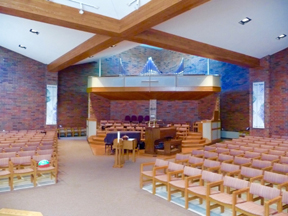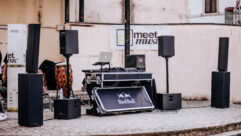
SVC Podcast – Show Notes – Show 140-1:
In this edition of the SVC Podcast, SVC Contributing Editor Bennett Liles talks with Kevin Crow of Excel AV Group in Minneapolis. Kevin describes a very unusual sound system design needed for the Good Shepherd Lutheran Church. The choir and altar area are spaced across the room from each other and monitoring for the choir was a challenge. The system was installed with iPad controllability and a very low power draw.
Links of interest:
- Excel AV Group in Minneapolis, Minnesota
- Danley TH112 Subwoofer
- Powersoft M50Q amplifier
- Allen & Heath ME-1 personal monitor mixer
Download Podcast Here:
https://s3.amazonaws.com/nb-svc/public/public/140-1_Excel_AV_Group_Good_…
From Sound & Video Contractor Magazine, this is the SVC Podcast with Kevin Crow. Show notes for the podcast are available on the web site of Sound & Video Contractor Magazine at svconline.com.
How do you make a brick box sound good? That was the task for Excel AV Group at the Good Shepherd Lutheran Church. They came up with a dual sound system design that brings the pastor, the musicians and the choir together. That’s coming up next on the SVC Podcast.
Kevin, it’s great to have you with us on the SVC Podcast from Excel AV Group in Minneapolis.
Yes.
So what’s been happening at Excel AV Group lately?
Well, things have been going great. We’re up quite a bit over last year revenue-wise We’ve had some really unique systems that we’ve put in this year; very, very challenging ones for sure, but we very much appreciate all of our networking partners and our manufacturers that have been supporting us. PowerSoft is definitely in that mix. [Timestamp: 1:15]
It sounds like it, and they had a big part to play in this thing. We’re talking about the installation at the Good Shepherd Lutheran Church. I’ve always liked Lutheran churches for having some very interesting architecture. They get very creative with their buildings. Describe this one. What sort of worship style do they have?
I think they get a little too creative at times with their architecture. This is just nothing more than a giant concrete brick box, so acoustically it was a challenge. They certainly did not want to add acoustical treatments because they very much have a traditional choir element as well as contemporary, which is common now. A lot of churches are moving that direction. So we analyzed the room and we looked at how to best design a new loudspeaker system and came up with that we really needed a dual system; one for spoken word, so that the sound was localized for spoken word from the front, and then one from the music area – which was actually in the back of the room – that would be localized for that so that the sound would sound like it was coming from the right direction. That was one of the biggest problems that I think they had with their previous older system, was that it just didn’t make sense and it didn’t sound right – especially for the musicians being time-delayed. So that’s what we did. [Timestamp: 3:32]
Yeah. And I noticed on some of the pictures they have brick walls?
Yeah. It’s all brick and it’s all hard surface. It’s terrible. It’s probably a three-and-a-half to four second reverb-timed room.
I figured I almost don’t have to ask how the acoustics are in there. They have kind of an interesting layout I think. Where is the sound control point located in relation to the altar and the musicians and all that?
Well, what we did is we’ve been doing a lot of this in these types of churches in the last few years. This is called an easy -based system for spoken word input, so all of the common, everyday inputs like the wireless for the pastor, the alter mic, podium mic – that type of thing – goes through what we call an easy mix. And we can simply use an iPad or a tablet to control it and give the client a very narrow volume window. And then when it comes to the music inputs, we have an Allen & Heath Qu-24 digital mixer that is in the actual music area. So they don’t have a dedicated sound person, but they do have a desk in the music area with the mixer on it. [Timestamp: 3:43]
Okay, so I would think that one of the things that they might have to get used to would be the physical separation between the choir and the altar and the front of house mixer.
Right. And in this case, this is very common where the music leader just manages sort of the spoken word and the music levels. But because the easy mix is wireless for the spoken word inputs, that tablet or iPad can be anywhere in the room. They could actually have it up front if they wanted, so it really doesn’t matter. [Timestamp: 4:14]
And where is the sort of man behind the curtain? Where is all of the rack equipment? Is that stashed in a closet somewhere or is that kept close by?
Mm-hmm. You know, because of the advancements in all the technology, the footprint for a lot of this equipment is drastically reduced. So we do have the equipment in the music area underneath the desk and the cabinetry, and it runs all of it. And thanks to PowerSoft, we’re able to power an entire sound system with one amplifier. It’s pretty incredible. [Timestamp: 4:46]
Yeah. I would think that would help in diagnostics, too. If anything does go wrong, it’s going to be easier to track down the trouble with everything right there with the operator. And they have separate front and rear sound systems. That seems like a fairly unusual situation.
You know, it is unusual. I would say a very small percentage of rooms is like this where you’ve got the music area so far away from the spoken word or the altar area. So because it’s so far away it doesn’t make sense to have one system firing in essentially the wrong direction. So it isn’t necessarily two systems, but it is two loudspeaker localized points of origin is probably the best way to put it. So we’ve got the Fulcrum DX-8’s that do the spoken word, and that is localized to the front. And then we have the Fulcrum CX-1526 speakers that are located just above the music area and so that the music is localized to their source. So actually it’s the right way to do it from a loudspeaker design standpoint, but yes, it is unconventional for sure. [Timestamp: 5:59]
It’s going to mean a more involved installation and a little more cabling but on the control, you’ve got ultimate versatility.
If you want to fall asleep fast you can look up on Wikipedia sound localization and read all you want about how to properly do it, but I think that a lot of people make a mistake in these kinds of rooms and put in speakers in the front when the sound source is in the back and that doesn’t really make sense to the ear. So it’s the right way to do it, I think. And what’s amazing is we’re able to power this entire system with one amplifier from PowerSoft. [Timestamp: 6:37]
And that’s the M50Q amp. I was going to ask you about that. Why did you decide on that one?
You know, we do a lot of the M series from PowerSoft. From a dollar-to-wattage standpoint you can’t just beat it, the output you get out of PowerSoft amps. We’re running not only the mains – the DX8’s – not only the mains for the music area with the Fulcrum CX, but we’re also powering the subwoofer with it. And to get a full system coming out of a half rack space amp like that, it blows me away, really. I never thought I’d see such a thing. Years ago we used to do so many amplifiers compared to what we do now. We also, from time to time based on the system design – not with this one, but some of our system designs – we’ll use the PowerSoft amps that have the integrated DSP and that brings even more value to it because we’re able to tune an entire system with the amplifier and DSP integrated. [Timestamp: 7:37]
Amps and DSP have come a long way, and for this setup having it all in the minimum footprint is a real plus. It would appear from that space that the choir monitoring might be an interesting problem. How does that work? Do they use monitor wedges?
They do. We have a couple of, I believe they’re the Turbosound monitor wedges; you know, very minimal though, one or two at very low levels. And we’ll put those in front of the choir and then try to train the customer that less is more. And they don’t always hear that, but they hear it in feedback if they don’t hear it, so. [Timestamp: 8:11]
Yeah. I think the choir is not going to be scrutinizing the mix like a bunch of audiophiles, but as long as they can keep time that’s what they need.
They can tune and hear the music, and thank God they’re not drummers who have ears that are blown away.
Yes, and with live music that can get into some acoustical challenges, too. I really appreciate the detail you’ve given us on this and in Part 2 we’ll get into the subwoofer, the iPad control and some other things, but it’s been fun hearing about this. It’s Kevin Crow from Excel AV Group in Minneapolis and the Good Shepherd Lutheran Church.
Thank you.
Thank you for being here with us for the SVC Podcast with Kevin Crow. Show notes are available on the website of Sound & Video Contractor Magazine at svconline.com. Be back with us next week for Part 2 when Kevin will get into the iPad control and powering at Good Shepherd Lutheran Church. On the next SVC Podcast.










